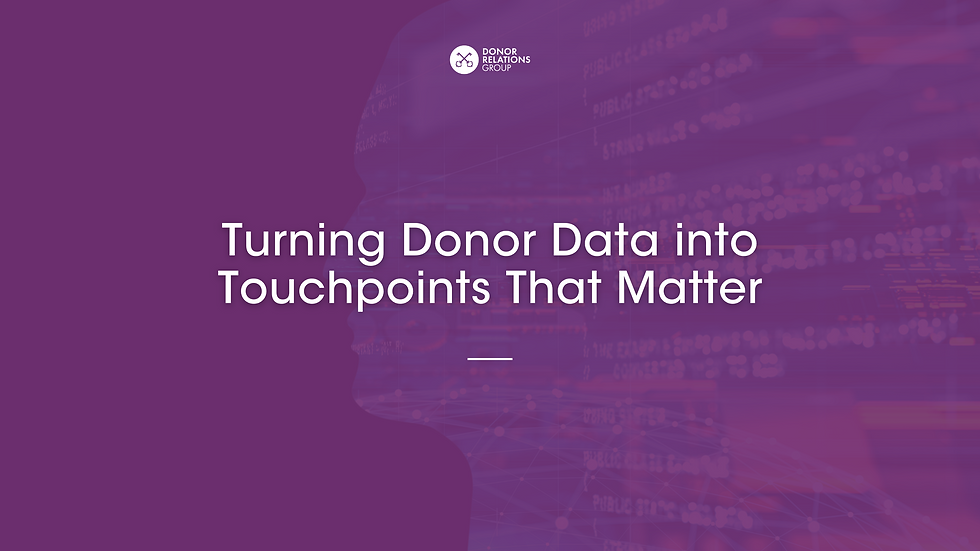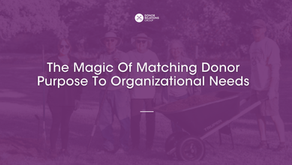How to Turn Donor Data into Touchpoints That Matter
- Lynne Wester

- Jul 24
- 6 min read
Updated: Jul 30

Donors want to feel seen and known.
Too often, we focus our donor communications on what we want them to do—give again, upgrade, attend. But personalized outreach flips that dynamic. It says, “We see you, we remember, and we care.” Using donor data strategically enables us to craft timely and relevant messages that deepen connections, and demonstrate to donors that their support truly matters.
Personalization isn’t always a heavy lift. Sometimes, a few thoughtful touches, supported by data you already have, can dramatically improve donor experience and retention.
In this post, I’ll walk you through a framework for integrating donor data into your communications projects, whether you're refreshing an existing donor relations plan or launching something entirely new. I’ll also share a real-life example from my time at the LSU Foundation, where we used giving milestone data to deepen donor relationships, even when larger plans had to pivot.
Step 1: Take Inventory – What Tools Do You Already Have?
Before launching a new data-informed project, it’s essential to take stock of what you already have.
Technology
What’s in your tech stack? Do you use platforms like ThankView, ODDER, StoryRaise, Mythos, or an email marketing tool?
How are you currently using them?
Are there personalization features you have yet to explore?
Many email platforms allow dynamic content blocks—messages that automatically adjust based on donor preferences or milestones. For example, ThankView lets you personalize videos within the same email campaign. If you haven’t used these features before, set aside time to experiment, or contact your tech rep to learn more.
Pro Tip: Create a spreadsheet of your available platforms and list the personalization features each one supports. You’ll likely find several options you’re not yet leveraging.
Existing Projects
Look at your current donor relations plan:
What ongoing projects could benefit from data personalization? Think acknowledgments, annual reports, holiday cards, event invites, and milestone recognitions.
What data do you have at your fingertips—giving anniversaries, years of consecutive support, areas of interest, preferred giving vehicles?
Now ask: Can any of those projects be enhanced by using those data points?
New Project Ideas
Sometimes your best personalization opportunity is one you haven’t launched yet.
Could you introduce behavior-based communications triggered by specific donor actions?
What about recognizing special anniversaries or highlighting giving history in a unique way?
At the LSU Foundation, we began by asking these same questions. We already had strong donor touchpoints in place, many of which had been enhanced using basic data points, such as name, designation, and giving level. We employed strategies to simplify complicated endowment data, but we knew we could do more.
We met as a team and mapped out a new strategy to move toward behavior-based stewardship—one that would help donors feel seen and valued at key moments. Our goal was to develop donor journeys tailored to specific milestones, such as giving anniversaries or first-time gifts.
Step 2: Formulate a Plan – Start Small and Prioritize
You probably have lots of ideas already, but don’t try to tackle everything at once. Instead:
Choose one project that will benefit the most from personalization
Define your scope: Will it be a one-time outreach or an ongoing effort?
Create a backlog of additional ideas to revisit later
Utilize a project management system or shared spreadsheet to keep track of your roadmap. Document your ideas now, so they’re ready when you need them.
Step 3: Identify Key Partners
No one executes a great data-driven project alone.
Partner with your advancement services or data team early. Explain what you’re trying to accomplish, not just the data fields you want to leverage.
Tap into vendor support: many technology platforms offer onboarding sessions or use-case reviews to help you get started. Take advantage of them.
Engage your communications or creative team if you need copy, design, or production support.
And be sure to loop in leadership if their buy-in or visibility is needed.
Pro Tip: Elevate your partnership with your data team by asking how they prefer to receive requests. Build a habit of sending context alongside your ask so they understand the “why.” Also, consider inviting them to a quarterly donor relations team meeting.
Step 4: Determine Feasibility
Once you’ve mapped your idea, you’ll need to gut-check its viability.
Can the data be reliably pulled?
Can your technology support the desired level of personalization?
Are there any time or resource constraints?
Do you have leadership support?
If the answer is “no,” pivot or scale back the project. Use what’s feasible today to pilot a version of your idea, then build on it later.
Sometimes, big ideas require a pivot. That’s exactly what we faced as we tried to implement our ambitious donor journey model. While we had mapped out a solid plan and felt confident about the strategy, we quickly realized we needed several key partners, including our data and communications teams, to bring it to life.
The timing, however, wasn’t ideal. We were transitioning to a new CRM system, and leadership was discussing structural changes that could impact our approach to engagement. Rather than shelving the project, we took a strategic baby step. We decided to launch a small, milestone-driven outreach using giving anniversary data. This was a manageable way to start moving toward behavior-based programming while testing our internal systems and partner alignment.
A Small Project, Big Impact: Our Giving Milestone Outreach
So, what did we do instead?
We partnered with our data team to build a giving milestone report that identified donors celebrating significant anniversaries of their first gift to LSU–both to the university and to specific colleges or units. For example, if a donor made their first gift to LSU ten years ago that month, they appeared in the report.
This approach required a fraction of the effort compared to our original donor journey plan. It was simple, scalable, and immediately actionable.
Instead of routing the project through our central communications team for full creative development, we created a clean, pre-approved email template that gift officers could personalize and send directly from their Outlook accounts.
Each month, we ran the report, flagged donors who would benefit from a memorable touchpoint, and shared both the list and the template with their assigned gift officers.
This small, but meaningful outreach was a success!
It allowed us to recognize milestones in real-time, empowered our frontline colleagues with easy-to-use tools, and provided donors with thoughtful messages that felt both timely and personal.
Most importantly, this simple project became a catalyst. It confirmed that our data and internal systems could support more targeted donor engagement, and it provided us with the confidence and proof of concept to build upon.
Step 5: Nail Down the Details
Now it's time to operationalize.
Finalize the data points: Are you pulling giving anniversaries, giving designations, preferred name formats?
Confirm file formats and delivery methods with partners.
Map your timeline: Who’s responsible for what, and when?
Use the RACI Model (Responsible, Accountable, Consulted, Informed) to align internal roles and responsibilities. Make sure everyone has access to your project plan.
BONUS: If you've never used the RACI Model, here's a free download to help you get started, with a link to spreadsheet template.
Step 6: Test (Seriously—Test)
This part takes time, but it’s essential. Trust me, I had to learn the hard way!
Test the data file to confirm the logic works as expected.
Review proofs—does the donor name populate correctly? Are the milestones accurate?
Consider a six-eye review: three people reviewing for content, logic, and formatting.
I recommend testing at least 20% of your dataset and including edge cases.
Step 7: Launch and Celebrate
Once your testing is complete and you’re confident in the setup, it’s time to launch.
This is the fun part where all your behind-the-scenes efforts become a meaningful touchpoint for your donors.
Don’t forget to take a moment to celebrate with your team (and thank your data partners!).
Step 8: Gather Feedback
Great donor relations work includes listening.
Ask your donors for feedback through a quick survey, email reply, or even a phone call from a gift officer.
Solicit internal feedback: What worked for your partners? What would they improve?
Document all insights—you’ll need them when planning your next project.
Step 9: Reflect and Plan Your Next Project
Use what you’ve learned to iterate. What would you do differently next time? Did your idea deliver the impact you hoped for?
Return to that backlog you created earlier and determine what project is ready to move forward next.
Wrapping Up: One Project, Many Possibilities
The milestone outreach became a launching point for behavior-based personalization. It gave us a repeatable framework, and showed our gift officers how even small, data-driven gestures could make a significant impact. But remember, it all began with one manageable, meaningful project that communicated to our donors: 'We see you, and you matter.’
Written by Stacey Halphen





